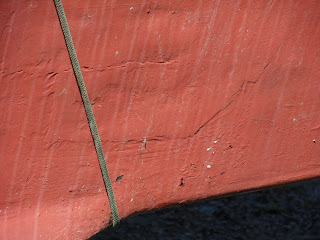Je dois cependant penser a l'ajout de poids que je dois limiter le plus possible. Il me serait possible de découper a la scie sauteuse, des grandes portions de panneaux dans le vieux contreplaqué des coques latérales, entre les varangues et les membrures. Je dois aussi penser aux matériaux que je vais utiliser et aux couts qui leurs sont associés. La seconde peau que j'avais appliqué par dessus le devant de la coque centrale était un Core-Cell 1/4" sur lequel j'avais laminé deux épaisseurs de fibre de verre 22 onces. Le Core-Cell est léger mais le fibre de verre et l'époxy nécéssaire, sont assez lourds. Et surtout très couteux. Un contreplaqué de BC-Fir 1/4" est plus lourd, a surface équivalente, qu'un panneau de Core-Cell d'épaisseur identique. Sauf que je n'aurais pas de besoin de laminer aussi épais de fibre de verre sur un contreplaqué. 12 onces seraient amplement suffisants comparé aux 44 onces sur le Core-Cell. La solution contreplaqué de BC-Fir 1/4" + 12 onces de fibre de verre serait, tous comptes faits, pas plus lourde que la solution Core-Cell 1/4" + 44 onces de fibre de verre. Et surtout, serait beaucoup moins couteuse.
Je me donne encore du temps pour y penser, de toutes facons, ce travail risque de se faire que l'année prochaine.
----------------------------------------------------------------------------------
For a few weeks already, I've been working on sealing the edges of those thin plywoods I applied on the old damaged floor all around the cabin. To do that task, I must fill the cavities with a fairing putty made of epoxy and microballoons. Then I must sand those edges to give them a round shape, that I cover with a thin fiberglass ply, and some more fairing at last. It is a very long and boring job. As I pulled up the tarps to expose those edges I am working on, it allowed me to see, at the same occasion, the sides of the lateral hulls. Of course, when I replace the tarps every fall, I can observe them at that time too. But then, at that moment, I am in a "tarp replacement" mood and I spend no time thinking about the state of the fiberglass on the lateral hulls themselves. This time though, I completely stop at it and I start thinking seriously about how I'm gonna fix all these damages, those botched repairs and hastily applied gel-coat done by the previous owners. I feel the simplest and quickest solution would be the same I used last year over the front section of the main hull, which is applying a second skin over the old one.
However, I must pay attention about adding weight. It would be possible to remove large chunks of the old hull panels with a jig-saw. I must also think about the materials I would use, and their cost. The second skin I applied on the front section of the main hull, was made of a 1/4" Core-Cell on which I laminated two 22 ounces fiberglass plies. The Core-Cell is lightweight but the fiberglass with its epoxy are rather heavy. And especially expensive. A 1/4" BC-Fir plywood is, at equivalent area, heavier than a Core-Cell panel of the same thickness. But I would not have to laminate the same thickness of fiberglass on a plywood. 12 ounces would be enough compared to the 44 ounces I laminated on the Core-Cell. Considering everything, the BC-Fir plywood + 12 ounces of fiberglass, would not be heavier than the Core-Cell panel + 44 ounces of fiberglass. But it would be lots cheaper.
I give myself some more time to think about it, anyways, that task is likely to be done only next year.





No comments:
Post a Comment